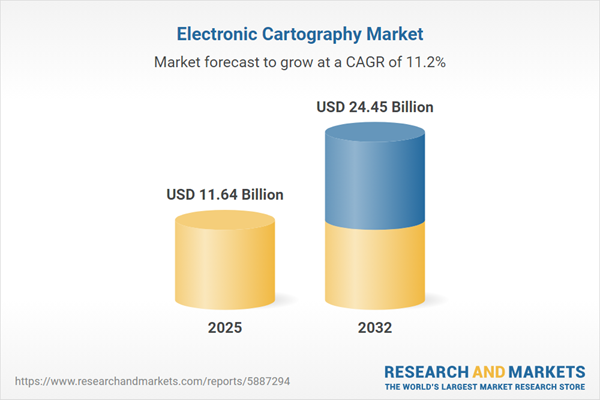Speak directly to the analyst to clarify any post sales queries you may have.
Enterprises are leveraging electronic cartography to transform complex operations with real-time geospatial intelligence, gaining the oversight needed for informed, strategic decisions as logistics and regulatory conditions evolve.
Market Snapshot: Electronic Cartography Market Size and Growth
The electronic cartography market is experiencing accelerated growth, with a current value of USD 10.46 billion in 2024 and projected expansion to USD 11.64 billion in 2025. This anticipated rise, supported by a compound annual growth rate (CAGR) of 11.19%, signifies robust ongoing momentum. The market is forecast to reach USD 24.45 billion by 2032, driven largely by digitization within transportation, logistics, and infrastructure. Senior decision-makers increasingly depend on geospatial mapping technology for agile operational planning, real-time data analytics, and workflow optimization to maintain competitive positioning.
Scope & Segmentation of the Electronic Cartography Market
Strategic segmentation within the electronic cartography market guides leadership in making targeted investments and managing assets efficiently. By clarifying operational needs, this segmentation supports effective procurement and compliance strategies in sophisticated business environments.
- Product Types: GPS handheld units, hardware mounting systems, in-vehicle navigation tools, electronic plotters, SaaS-based mapping platforms, and customizable mobile or desktop mapping applications serve distinct business requirements.
- Applications: Deployed in automotive navigation, fleet tracking, route optimization, smart city management, emergency response, and live traffic analysis to address diverse industry challenges.
- Deployment Models: On-premise, public cloud, private cloud, and hybrid solutions align with enterprise compliance standards, scalability, and budget considerations.
- End Users: Logistics firms, transport companies, utilities, energy providers, e-commerce, retail, and public and private sector organizations use electronic cartography for robust asset visibility and navigation insights.
- Regional Coverage: Adoption patterns vary with local infrastructure, regulatory practices, and investment climates in the Americas, Europe, Asia-Pacific, and Middle East & Africa, requiring adaptive strategies for market entry and service delivery.
- Technologies: IoT sensor integration, artificial intelligence, machine learning, edge computing, modern positioning systems, and cloud-native platforms drive continuous innovation, improving accuracy and operational efficiency.
- Key Companies: Google LLC, ESRI, HERE Global, TomTom, Apple, Microsoft, Garmin, Hexagon, Trimble, and Mapbox are at the forefront, contributing to a dynamic ecosystem of specialized mapping solutions.
Key Takeaways for Senior Decision-Makers
- Advanced electronic cartography systems provide organizations with improved operational oversight and timely, data-driven strategy alignment.
- Flexible deployment—including on-premise, cloud, and hybrid models—enables compliance with varying regulatory and risk management requirements.
- Interoperability with core enterprise platforms and diverse operating systems ensures integration across business functions and technology portfolios.
- Comprehensive geospatial insights allow for refined planning in urban development, emergency readiness, and critical infrastructure projects.
- Regional standards and evolving compliance expectations require adaptive tactics for sustained risk mitigation and uninterrupted service provision.
- Hardware and cloud provider collaboration delivers industry-specific functionality for complex, mission-oriented operational contexts.
Tariff Impact: Supply Chain and Pricing Adaptations
Recent changes in U.S. tariffs have resulted in higher hardware costs throughout the electronic cartography supply chain. In response, producers are diversifying sourcing strategies and strengthening supply chain resilience to better manage pricing fluctuations. Software providers are adjusting enterprise licensing models for more consistency and predictability. As a result, enterprises are increasingly favoring private cloud and on-premise deployments for enhanced compliance, cost control, and operational autonomy. Public sector and emergency services are turning to modular, adaptable mapping systems to ensure continuity amid evolving regulatory landscapes.
Methodology & Data Sources
Findings in this report draw on executive interviews, in-depth stakeholder surveys, regulatory review, and analysis of leading industry whitepapers. Insights integrate perspectives from geospatial intelligence professionals for a well-rounded market view.
Why This Report Matters
- Delivers actionable market intelligence to support strategic leadership and technology planning within evolving regulatory environments.
- Equips procurement teams with well-defined segmentation and regional insights for effective technology investments and streamlined resource management.
- Offers well-established best practices for adopting resilient, compliant mapping systems that sustain organizational value and enable secure operations.
Conclusion
Electronic cartography empowers organizations with data-driven visibility and adaptability, supporting agile responses to shifting market requirements and helping align operational objectives with long-term strategy.
Additional Product Information:
- Purchase of this report includes 1 year online access with quarterly updates.
- This report can be updated on request. Please contact our Customer Experience team using the Ask a Question widget on our website.
Table of Contents
3. Executive Summary
4. Market Overview
7. Cumulative Impact of Artificial Intelligence 2025
Companies Mentioned
The companies profiled in this Electronic Cartography market report include:- Google LLC
- Environmental Systems Research Institute, Inc.
- HERE Global B.V.
- TomTom N.V.
- Apple Inc.
- Microsoft Corporation
- Garmin Ltd.
- Hexagon AB
- Trimble Inc.
- Mapbox, Inc.
Table Information
| Report Attribute | Details |
|---|---|
| No. of Pages | 185 |
| Published | October 2025 |
| Forecast Period | 2025 - 2032 |
| Estimated Market Value ( USD | $ 11.64 Billion |
| Forecasted Market Value ( USD | $ 24.45 Billion |
| Compound Annual Growth Rate | 11.1% |
| Regions Covered | Global |
| No. of Companies Mentioned | 11 |









